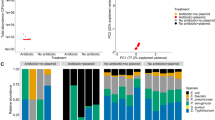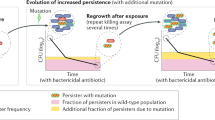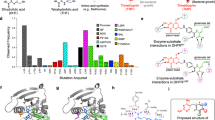Abstract
Antibiotics are often unstable and can decay into various compounds with potential biological activities. We found that as tetracycline degrades, the competitive advantage conferred to bacteria by resistance not only diminishes but actually reverses to become a prolonged disadvantage due to the activities of more stable degradation products. Tetracycline decay can lead to net selection against resistance, which may help explain the puzzling coexistence of sensitive and resistant strains in natural environments.
This is a preview of subscription content, access via your institution
Access options
Subscribe to this journal
Receive 12 print issues and online access
$259.00 per year
only $21.58 per issue
Buy this article
- Purchase on Springer Link
- Instant access to full article PDF
Prices may be subject to local taxes which are calculated during checkout


Similar content being viewed by others
Change history
12 February 2010
In the version of this article initially published, one funding source was missing from the acknowledgments. The error has been corrected in the HTML and PDF versions of the article.
References
Kieser, T, Bibb, M.J., Buttner, M.J., Chater, K.F. & Hopwood, D.A. Practical Streptomyces Genetics (John Innes Foundation, Norwich, UK, 2000).
Yim, G., Wang, H.H. & Davies, J. Phil. Trans. R. Soc. Lond. B 362, 1195–1200 (2007).
Linares, J.F., Gustafsson, I., Baquero, F. & Martinez, J.L. Proc. Natl. Acad. Sci. USA 103, 19484–19489 (2006).
Price-Whelan, A., Dietrich, L.E. & Newman, D.K. Nat. Chem. Biol. 2, 71–78 (2006).
Dantas, G., Sommer, M.O., Oluwasegun, R.D. & Church, G.M. Science 320, 100–103 (2008).
Walsh, C. Antibiotics: Actions, Origins, Resistance (American Society for Microbiology Press, Washington, DC, 2003).
D'Costa, V.M., McGrann, K.M., Hughes, D.W. & Wright, G.D. Science 311, 374–377 (2006).
Halling-Sorensen, B., Sengelov, G. & Tjornelund, J. Arch. Environ. Contam. Toxicol. 42, 263–271 (2002).
Bochner, B.R., Huang, H.C., Schieven, G.L. & Ames, B.N. J. Bacteriol. 143, 926–933 (1980).
Chopra, I., Hawkey, P.M. & Hinton, M. J. Antimicrob. Chemother. 29, 245–277 (1992).
Sarmah, A.K., Meyer, M.T. & Boxall, A.B. Chemosphere 65, 725–759 (2006).
Yuen, P.H. & Sokoloski, T.D. J. Pharm. Sci. 66, 1648–1650 (1977).
Jia, A., Xiao, Y., Hu, J., Asami, M. & Kunikane, S. J. Chromatogr. A 1216, 4655–4662 (2009).
Moyed, H.S., Nguyen, T.T. & Bertrand, K.P. J. Bacteriol. 155, 549–556 (1983).
Eckert, B. & Beck, C.F. J. Bacteriol. 171, 3557–3559 (1989).
Lederer, T. et al. Biochemistry 35, 7439–7446 (1996).
Nguyen, T.N., Phan, Q.G., Duong, L.P., Bertrand, K.P. & Lenski, R.E. Mol. Biol. Evol. 6, 213–225 (1989).
Hegreness, M., Shoresh, N., Hartl, D. & Kishony, R. Science 311, 1615–1617 (2006).
Chait, R., Craney, A. & Kishony, R. Nature 446, 668–671 (2007).
Lenski, R.E. et al. Mol. Ecol. 3, 127–135 (1994).
Kishony, R. & Leibler, S. J. Biol. 2, 14 (2003).
Kelly, R.G. & Buyske, D.A. J. Pharmacol. Exp. Ther. 130, 144–149 (1960).
Levy, S.B., FitzGerald, G.B. & Macone, A.B. N. Engl. J. Med. 295, 583–588 (1976).
Bliss, C.I. Ann. Appl. Biol. 26, 585–615 (1939).
McCormick, J.R., Jensen, E.R., Johnson, S. & Sjolander, N.O. J. Am. Chem. Soc. 90, 2201–2202 (1968).
Acknowledgements
We thank R. Lenski (Michigan State University) for the gift of plasmids, and we thank R. Chait, D. Kahne and F. Solomon for helpful insights and R. Ward and M. Elowitz for comments on the manuscript. This work was supported in part by the Bill and Melinda Gates Foundation through the Grand Challenges Exploration Initiative, US National Institutes of Health grant R01 GM081617 (to R.K.) and a George Murray Scholarship (to A.C.P.).
Author information
Authors and Affiliations
Contributions
A.C.P., E.A. and R.K. designed research; A.C.P. performed research and analyzed data; A.C.P. and R.K. wrote the manuscript.
Corresponding author
Supplementary information
Supplementary Text and Figures
Supplementary Figures 1–8 and Supplementary Methods (PDF 763 kb)
Rights and permissions
About this article
Cite this article
Palmer, A., Angelino, E. & Kishony, R. Chemical decay of an antibiotic inverts selection for resistance. Nat Chem Biol 6, 105–107 (2010). https://doi.org/10.1038/nchembio.289
Received:
Accepted:
Published:
Issue Date:
DOI: https://doi.org/10.1038/nchembio.289
This article is cited by
-
Antibiotic resistance in the environment: a critical insight on its occurrence, fate, and eco-toxicity
Environmental Science and Pollution Research (2021)
-
Interaction variability shapes succession of synthetic microbial ecosystems
Nature Communications (2020)
-
Degradation and transformation of fluoroquinolones by microorganisms with special emphasis on ciprofloxacin
Applied Microbiology and Biotechnology (2019)
-
Plasticity, dynamics, and inhibition of emerging tetracycline resistance enzymes
Nature Chemical Biology (2017)
-
Next-generation approaches to understand and combat the antibiotic resistome
Nature Reviews Microbiology (2017)



